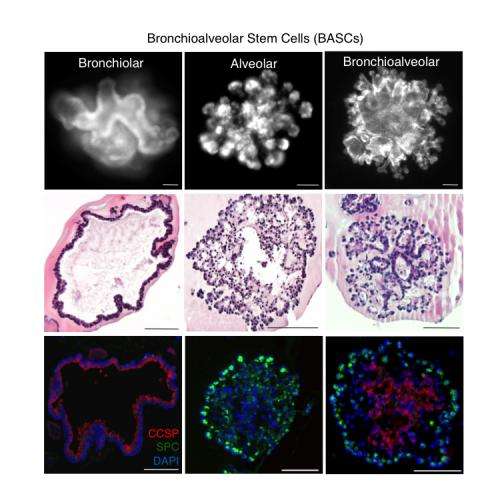Researchers reverse some lung diseases in mice by coaxing production of healthy cells

It may be possible one day to treat several lung diseases by introducing proteins that direct lung stem cells to grow the specific cell types needed to repair the lung injuries involved in the conditions, according to new research at Boston Children's Hospital.
Reporting in the January 30th issue of Cell, researchers led by Carla Kim, PhD, and Joo-Hyeon Lee, PhD, of the Stem Cell Research Program at Boston Children's, describe a new pathway in the lung, activated by injury, that directs stem cells to transform into specific types of cells. By enhancing this natural pathway in a mouse model, they successfully increased production of alveolar epithelial cells, which line the small sacs (alveoli) where gas exchange takes place. These cells are irreversibly damaged in diseases like pulmonary fibrosis and emphysema.
By inhibiting the same pathway, the researchers ramped up production of airway epithelial cells, which become damaged in diseases affecting the lung's airways, such as asthma and bronchiolitis obliterans.
Using a novel 3D culture model that mimics the environment of the lung, the researchers showed that even a single lung stem cell could be coaxed into producing alveolar and bronchiolar epithelial cells. By adding a protein known as thrombospondin-1 (TSP-1) to these cultures, they prodded the stem cells to generate alveolar cells.
Kim and Lee conducted experiments using a live mouse model of fibrosis. By simply taking the endothelial cells that line the lung's many small blood vessels—which naturally produce TSP-1—and directly injecting the liquid surrounding the cultured cells into the mice, they were able to reverse the lung damage.
Conversely, when the team used lung endothelial cells that lacked TSP-1 in the 3D cultures, the stem cells produced more airway cells. In live mice engineered to lack TSP-1, airway repair was enhanced after injury.
"When lung cells are injured, there seems to be a cross talk between the damaged cells, the lung endothelial cells and the stem cells," says Lee, who is first author on the paper.
"We think that lung endothelial cells produce a lot of repair factors besides TSP-1," adds Kim, the paper's senior author. "We want to find all these molecules, which could provide additional therapeutic targets."















